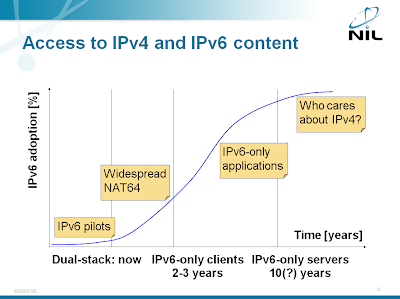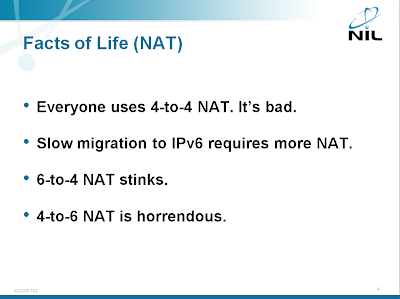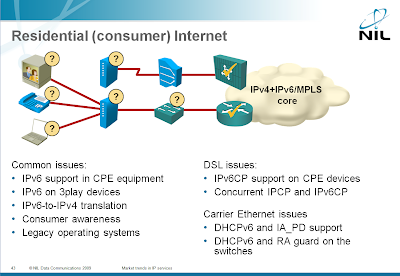Category: IPv6
Slovenians presenting leading-edge IPv6 @ Google
Jan Žorž from go6.si is obviously a very successful IPv6 evangelist: not only did he manage to organize numerous IPv6 summits in Slovenia (which is probably one of the reasons Slovenia is the leading European country on the RIPEness scale); he’s also helped persuade the mobile industry to roll out pilot IPv6 services. Right now we have two mobile operators piloting IPv6; both dual-stack (with two PDP contexts) and IPv6 roaming are working flawlessly.
BTW, Jan still doesn’t understand the need to blog in English, so you all the links to his web site I’m including in this post are converted into English-resembling form by Google Translate.
Not surprisingly, such feats did not go unnoticed: Jan has been invited to present at the Google IPv6 Implementors Conference and managed to persuade Google to include an engineer from our local CPE manufacturer in the IPv6 CPE vendor panel.
I have nothing more to say than: CONGRATULATIONS & GOOD LUCK!
Is NAT64 a subset of NAT-PT?
Quick summary for the differently attentive: Even without the DNS processing, NAT-PT and NAT64 differ from the perspective of peer-to-peer applications. The differences don’t matter for IPv6 clients connecting to IPv4 servers.
Whenever I’m talking about NAT64, someone would say “we’re already using it”. As it turns out, they’re usually using NAT-PT, which looks a lot like NAT64 from afar (after all, they both allow IPv6-only clients to connect to IPv4-only servers). However, there are significant differences between the two, the most important one being DNS64, which handles DNS processing completely outside of the forwarding path (NAT-PT has embedded DNS Application Level Gateway, which was one of the major reasons NAT-PT was declared broken beyond hope).
The first step on the path to CGv6
In another interesting timing coincidence, the documentation for IOS-XR release 3.9.1 appeared at approximately the same time (probably a little bit later) as I started to research the viability of CGv6 during the preparation for my NAT64/DNS64 presentation.
A kind guest has provided links to configuration guide and command reference in a comment to my blog post. Thank you!
Looking at the release notes, the CGSE blade currently supports only CGN (large-scale NAT44), the interesting parts (NAT64 or DS-lite AFTR) are still in the pipeline.
CGv6 – how real is it?
Last November I was delighted to read the announcement describing how a module in CRS-1 was going to support CGN, NAT444, NAT64 and DS-Lite. It looked like a major vendor has finally decided it’s time to solve the IPv4-to-IPv6 transition problem.
However, I was not able to find anything beyond a few fancy videos, a white paper and a brochure. Can anyone shed more light on CGv6? Have you seen it running outside of PowerPoint? When can an IPv6-embracing Service Provider expect to see it on an ASR 1000?
And before you ask ... no, CGv6 is not described in my webinars; I only talk about features (not futures) that I was able to get my hands on.
The role of NAT in transition to IPv6
I was invited to present my thoughts on NAT64 and DNS64 in the upcoming 3rd Slovenian IPv6 Summit (well, they still haven’t managed to create a bilingual site, so here's the same page from the perspective of Google Translate). While preparing for the presentation, I’ve greatly enjoyed reading the Framework for IPv4/IPv6 Translation IETF draft. I would highly recommend it; it’s rare to find such a concise and instructive document and it’s a mandatory reading if you want to understand the role of NAT in the IPv4-to-IPv6 transition.
The role of NAT64 in enterprise networks is described in the Enterprise IPv6 Deployment workshop.
IPv6 myths are alive and well
One would hope that the IPv6 myths are slowly fading away as more people get exposed to IPv6 ... but if you like them, don’t worry; they are constantly being recycled. The IPv6: Why Bother? article published by InformIT is a perfect example:
With IPv6, there are enough addresses now that every country or major network can be assigned a large range. It can then assign subranges within that to networks that it connects to, and so on. This hierarchical assignment (in theory, at least) simplifies routing decisions.
Poll results: Internet traffic transport options
I was somewhat surprised by the results of my recent “Do you use MPLS to transport Internet traffic?” poll. I had assumed that most Service Provider networks today use MPLS-based BGP-free core, but almost half of the respondents transport Internet traffic natively.

More details: Seven IPv6 myths
Two weeks ago I listed six IPv6 myths, asking you to add your own favorites. Obviously the MythBusters are not reading my blog and everyone else decided to focus on a single provocative sentence (got you!) and expressed strong feelings about NAT being (or not being) a security feature.
I've described the myths (including the mobility myth to get their number up to the nearest magic number) in more details in the Seven IPv6 networking myths that don't match reality article published by SearchTelecom.
This is how you design a useful protocol
A post in the My CCIE Training Guide pointed me to the GoogleTechTalk given by Yakov Rekhter (one of the fathers of BGP) in 2007. You should watch the whole video (it helps you understand numerous BGP implementation choices), but its most important message is undoubtedly the Design by Pragmatism approach:
- They had a simple, manageable problem (get from a spanning-tree Internet topology to a mesh topology).
- They did not want to solve all potential future problems; they left that marvelous task to IDRP (which still got nowhere the last time I've looked).
- They started with simple specifications (three napkins), had two interoperable implementations in a few months, and wrote the RFC after BGP was already in production use.
- They rolled it out, learnt from its shortcomings and fixed it.
- They gradually made it easily extensible: TLV encoding, optional attributes, capabilities negotiations. This approach made it possible to carry additional address families in BGP and use it for applications like MPLS VPN and VPLS.
One could only hope that the IPv6 architects had used the same approach ... but as Yakov said in his talk, that’s “water under the bridge”.
IPv6 Myths
Once you’ve spent a few hours trying to understand the implications of IPv6, you quickly realize that the only significant change is the increase in the address length. All the other goals that some people had been talking about were either forgotten or failed due to huge mismatch between idealistic view of the Internet IPv6 developers had 15 years ago and today’s reality. However, you still find mythical properties of IPv6 propagated across the Internet. Here are a few I’ve found; add your favorites in the comments.
IPv6 provides service/location separation. Total nonsense. The only mechanism used to find services is still DNS and it’s still used from the wrong position in the protocol stack.
My customers are not interested in IPv6 ... what can I do?
Shivlu left an interesting comment to my IPv6 is not ready for residential deployment post. He wrote: “Still no customer is ready for IPv6. How do I convince them?” The unfortunate answer to this problem is: you can't, but they'll only hurt themselves. If they persist long enough, they’ll become obsolete.
The migration issues are just one of the topics covered in the Enterprise IPv6 Deployment workshop. You can attend an online version of the workshop or we can organize a dedicated event for your team.
The web content providers have long realized that their customers have too many choices. Zvezdan Martič, one of the participants in the last year’s Slovenian IPv6 summit roundtable succinctly explained this phenomenon: “nobody cares whether my web site can be viewed in Internet Explorer or Firefox; if I don’t support the major browsers, the customers will find one of my competitors that does.”
IPv6 CPE router requirements
It’s almost unbelievable: more than 10 years after the IPv6 specs have been completed, someone finally realized it would be a good idea to specify the minimum requirements for a decent IPv6 CPE router. While this document will not solve the lack of low-cost IPv6-ready CPE devices, it’s definitely a step in the right direction, more so as it clearly acknowledges the need for DHCPv6 (some people still believe SLAAC is the solution to every problem ever invented).
Here are a few highlights from the document:
NAT-PT is totally broken in late IOS releases
When the current variant of IPv6 was selected 15 years ago, seamless integration with IPv4 was a big deal, resulting in NAT-PT architecture. NAT-PT tried to solve too many problems and (as I pointed out in my IPv6 Deployment workshop), while the 6to4 NAT is manageable, the 4to6 NAT is horrific (NAT64 and DNS64 are more reasonable; more about them in an upcoming post).
NAT between IPv4 and IPv6 hosts is just one of the topics covered in the Enterprise IPv6 Deployment workshop. You can attend an online version of the workshop or we can organize a dedicated event for your team.
To make matters worse, the NAT-PT implemented in Cisco IOS is totally broken due to removal of fast switching support in IOS release 12.4(20)T and numerous other releases. As I wrote a year and a half ago, removing fast switching will bite us eventually … and so it does when you try to use NAT-PT.
IPv6 is not ready for residential deployment
The main driver for IPv6 deployment is the IPv4 address space exhaustion, caused primarily by fast growth of residential users.
Each residential user needs an IP address, a small company doesn’t need anything more and even a reasonably-sized company can survive with a few IP addresses.
One would expect the vendor readiness to follow this pattern, but the situation is just the opposite: while the enterprise networking devices have pretty good IPv6 support (Data Center components from some vendors are a notable exception), the vendors serving the residential market don’t care.
The Service Provider-related IPv6 challenges are covered in my Market trends in Service Provider networks workshop. You can attend a web-based tutorial version or we can organize a dedicated workshop event for your team.
IPv6 in the campus but not in the Data Center?
Cisco has recently published two excellent design guides: Deploying IPv6 in Campus Networks and Deploying IPv6 in Branch Networks. As expected from the engineers writing Cisco’s design documents, these guides contain tons of useful information and good recommendations; they’re a highly recommended reading if you’ve started considering IPv6 deployment in your enterprise network. These design guides are part of Design Zone for Branch and Design Zone for Campus.
IPv6 deployment issues are just one of the topics covered in the Enterprise IPv6 Deployment workshop. You can attend an online version of the workshop or we can organize a dedicated event for your team.



